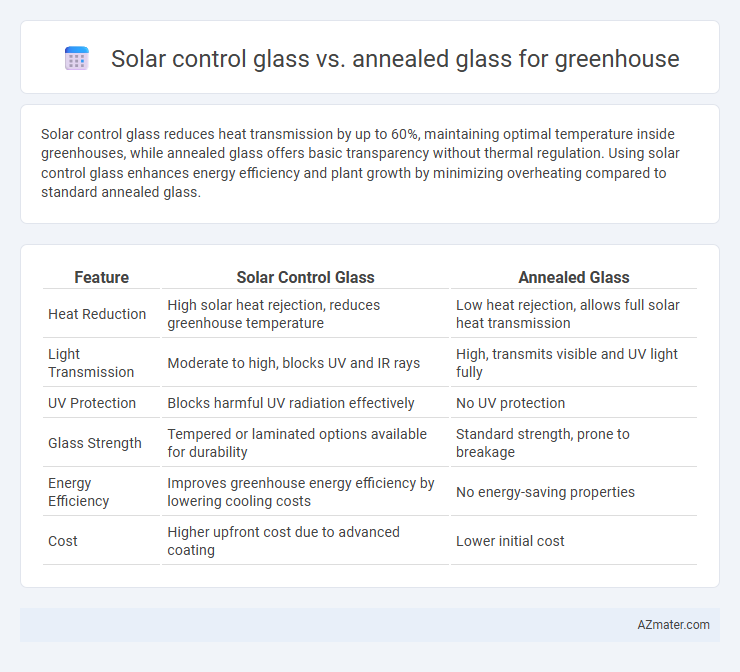Solar control glass reduces heat transmission by up to 60%, maintaining optimal temperature inside greenhouses, while annealed glass offers basic transparency without thermal regulation. Using solar control glass enhances energy efficiency and plant growth by minimizing overheating compared to standard annealed glass.
Table of Comparison
| Feature | Solar Control Glass | Annealed Glass |
|---|---|---|
| Heat Reduction | High solar heat rejection, reduces greenhouse temperature | Low heat rejection, allows full solar heat transmission |
| Light Transmission | Moderate to high, blocks UV and IR rays | High, transmits visible and UV light fully |
| UV Protection | Blocks harmful UV radiation effectively | No UV protection |
| Glass Strength | Tempered or laminated options available for durability | Standard strength, prone to breakage |
| Energy Efficiency | Improves greenhouse energy efficiency by lowering cooling costs | No energy-saving properties |
| Cost | Higher upfront cost due to advanced coating | Lower initial cost |
Introduction: Solar Control Glass vs Annealed Glass for Greenhouses
Solar control glass enhances greenhouse energy efficiency by reducing heat gain and blocking harmful UV rays, promoting optimal plant growth. Annealed glass, while cost-effective and easier to cut or shape, lacks the reflective coatings that regulate solar heat, leading to higher interior temperatures. Choosing solar control glass over annealed glass supports climate control and energy savings in greenhouse environments.
Understanding Solar Control Glass Technology
Solar control glass technology for greenhouses is designed to reduce heat gain by reflecting and absorbing specific solar wavelengths while allowing natural light to pass through, improving energy efficiency and plant growth conditions. Unlike annealed glass, which is standard float glass cooled slowly to relieve internal stresses, solar control glass incorporates coatings or tints that enhance thermal regulation, reducing the need for artificial cooling. This advanced glass type supports a stable internal climate by minimizing infrared and ultraviolet radiation, essential for optimizing greenhouse productivity and protecting delicate crops.
What is Annealed Glass? Core Properties Explained
Annealed glass is a type of float glass that undergoes a slow cooling process to relieve internal stresses, making it more stable but relatively weaker than tempered or laminated glass. It offers excellent clarity and is commonly used in greenhouses due to its affordability and ease of cutting or shaping, but it lacks solar control features such as UV filtering or heat reduction. For greenhouse applications where temperature regulation and energy efficiency are critical, solar control glass typically outperforms annealed glass by reducing heat buildup and protecting plants from harmful ultraviolet rays.
Light Transmission: Which Glass Maximizes Plant Growth?
Solar control glass reduces light transmission by filtering excess solar radiation, helping regulate temperature and protect plants from overheating in greenhouses. Annealed glass allows higher light transmission, maximizing the amount of natural sunlight reaching plants, which is essential for photosynthesis and growth. For maximizing plant growth, annealed glass often outperforms solar control glass due to its superior light transmission, but careful climate control is necessary to prevent heat stress.
Thermal Performance: Managing Greenhouse Temperatures
Solar control glass significantly improves thermal performance in greenhouses by reducing heat buildup through selective solar heat rejection, maintaining optimal internal temperatures for plant growth. Annealed glass lacks this capability, often leading to higher internal temperatures and increased cooling demands due to its standard heat transmission properties. Efficient temperature management with solar control glass enhances energy savings and plant health by minimizing thermal fluctuations inside the greenhouse.
UV and Infrared Protection Capabilities
Solar control glass provides superior UV and infrared protection compared to annealed glass, significantly reducing heat buildup and harmful UV radiation inside greenhouses. Its specialized coatings reflect infrared rays while allowing optimal visible light transmission, enhancing plant growth conditions and reducing cooling energy costs. In contrast, annealed glass lacks these advanced protective properties, offering minimal UV and infrared filtration, which can lead to higher temperatures and potential UV damage to plants.
Durability and Lifespan: Long-Term Value
Solar control glass offers enhanced durability and a longer lifespan compared to annealed glass, making it a superior choice for greenhouses exposed to harsh weather conditions. This type of glass resists scratches, impacts, and thermal stress more effectively, reducing the likelihood of breakage and maintenance costs over time. Its long-term value is reflected in sustained energy efficiency, UV protection, and structural integrity, ensuring a reliable environment for plant growth and significant cost savings.
Cost Comparison: Investment and Operating Expenses
Solar control glass typically involves higher initial investment costs compared to annealed glass due to advanced coatings and manufacturing processes, but it significantly reduces operating expenses by minimizing heat gain and lowering cooling energy consumption in greenhouses. Annealed glass, while less expensive upfront, leads to higher energy costs as it lacks thermal insulation properties, causing increased reliance on HVAC systems to maintain optimal growing conditions. Over the lifecycle of a greenhouse, solar control glass offers a more cost-effective solution through energy savings despite its premium price.
Sustainability and Environmental Impact
Solar control glass enhances greenhouse sustainability by reducing energy consumption through its ability to reflect infrared radiation and minimize heat gain, promoting a stable internal environment with lower cooling needs. Annealed glass, while cost-effective, offers minimal insulation and solar control, leading to higher energy use for temperature regulation and increased carbon footprint. Opting for solar control glass supports environmental impact goals by improving energy efficiency and reducing greenhouse gas emissions associated with climate control systems.
Choosing the Right Glass for Your Greenhouse Needs
Solar control glass significantly reduces heat buildup and blocks harmful UV rays, making it ideal for greenhouses aiming to maintain optimal internal temperatures and protect plants. Annealed glass offers affordability and clarity but lacks thermal regulation, which can lead to overheating and increased energy costs. Choosing the right glass depends on balancing plant requirements, climate conditions, and energy efficiency goals for a sustainable greenhouse environment.

Infographic: Solar control glass vs Annealed glass for Greenhouse
 azmater.com
azmater.com